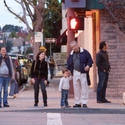I drove out to a distant suburb recently to attend to some business and I passed by a cluster of billboards on the side of the freeway that got me thinking. The general gist of the slogans asserted a conservative anti-government anti-urban rebellion. These are clearly people who don’t want density and public transit imposed on them by pointy headed liberal idiots. I have to admit I have some sympathy for this perspective, although probably not for the same reasons as the billboard people. read more »
Planning
Small Regions Rising
In the last 25 years there has been a huge change in the level of competitiveness of smaller urban areas – by which I mean the small end of the major urban scale, or metro areas of about one to three million people – that has put them in the game for people in residents in way they never were before.
I recently gave the morning keynote at the Mayor’s Development Roundtable in Oklahoma City and talked a bit about this phenomenon, as well as how these generally younger and sprawling areas ought to be thinking about their future. read more »
- Login to post comments
The California Dream has Moved Away
Southern California faces a serious middle income housing affordability crisis. I refer to middle income housing, because this nation has become so successful in democratizing property ownership that the overwhelming majority of middle income households own their own homes in most of the country. read more »
- Login to post comments
Growth Concentrated in Most Suburbanized Core Cities
An analysis of the just-released municipal population trends shows that core city growth is centered in the municipalities that have the largest percentage of their population living in suburban (or exurban) neighborhoods.
Improved Urban Core Analysis read more »
- Login to post comments
Celebrating Strips Malls: Strength in Standardization
Our current urbanized form has become remarkably homogenous. Anywhere in Florida, and in much of the United States, one now experiences a new sense of sameness in the texture and the pace of places. America has entered a period of uniform buildings, roads, and infrastructure, differing only in the details. We live in a very standardized America today. read more »
- Login to post comments
Who Benefits From Other People's Transit Use?
In the May 11 issue of Finance and Commerce, Matt Kramer, a local Chamber of Commerce representative lobbying for additional public transit and transportation spending (currently being debated at the Minnesota Legislature) is quoted as saying “Every person who is riding transit is one less person in the car in front of us.” read more »
- Login to post comments
How Cities Can Show Resilience
Resilient: Strong. Healthy. Successful again. But how does a city become resilient? Here are five ways that city leaders can help:
Designing for resilience requires systems thinking: Cities are complex, interconnected systems. Think of a city as being like a human body – a harmonious balance of cardiovascular, skeletal, respiratory, and cognitive functions. Each system is dependent on the next, and is easily stressed when unbalanced or shocked after trauma. An obvious example is PTSD, once known as “shell shock,” affecting so many military veterans today. read more »
- Login to post comments
Land Use Regulations and “Social Engineering”
All forms of land use regulation are explicitly “social engineering”. Full stop. Let’s acknowledge that reality as we move forward. The question is never whether we’ll be engaging in manipulating society through land use regulations, but how and why. read more »
- Login to post comments
Driving Farther to Qualify in Portland
Portland has been among the world leaders in urban containment policy. And, as would be predicted by basic economics, Portland has also suffered from serious housing cost escalation, as its median multiple (median house price divided by median household income) has risen from a normal 3.0 in 1995 to 4.8 in 2014. read more »
Silicon Valley: Jelly in the Jam
My last post was about how Silicon Valley is evolving into an urban form that’s not quite leafy and open enough to be a suburb anymore, but not really vibrant and compact enough to be a proper city either. “Too thin to be jelly. Too thick to be jam.” The story got an unusually large number of visits. I received some well informed comments that touched on the reality that Silicon Valley is a big place and I shouldn’t generalize. Palo Alto is very different from Fremont and so on. read more »
- Login to post comments






















